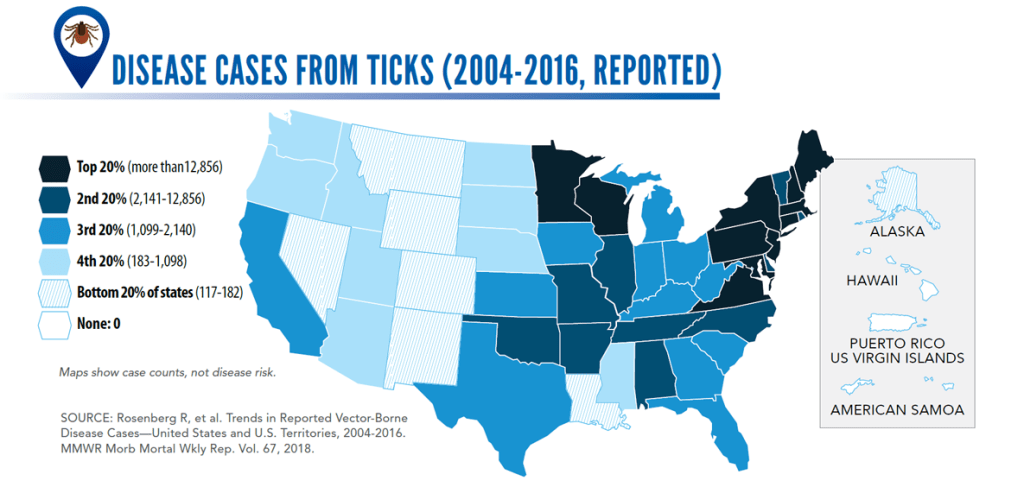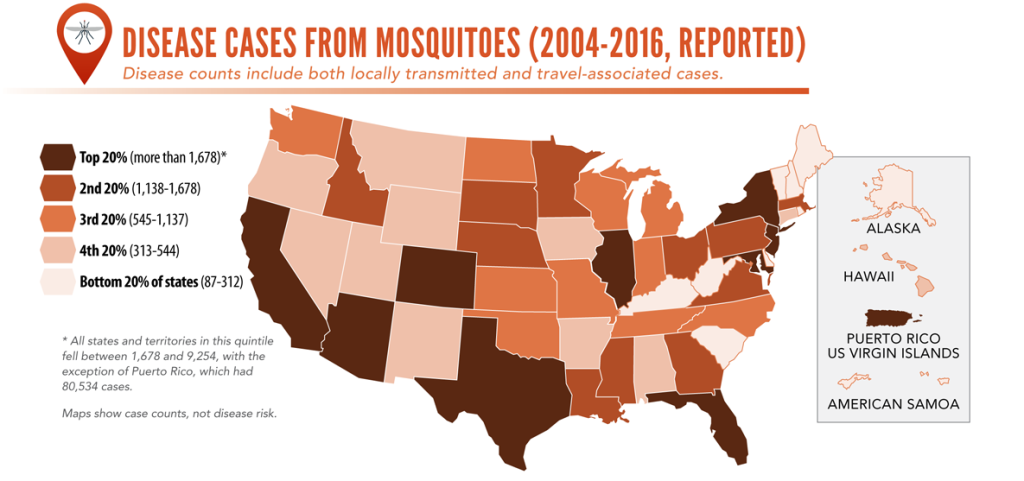You might have already seen reports that illnesses from mosquito, tick and flea bites have tripled in the last 13 years, according to federal health officials. Yikes. But before you head straight into worry, read on for more information and ways to keep yourself safe.
The Centers for Disease Control and Prevention (CDC) did not go so far as to say that we should all stay inside. Instead, there are simple ways to protect yourself—and especially your kids—which you’ll find at the end of this article.
Vector-borne diseases are illnesses transmitted by vectors (blood-feeding ticks and insects) through their bite. In the continental United States, cases of tick-borne diseases are increasing, whether from established infections like Lyme disease or new ones like the Heartland virus. Mosquito-borne diseases are becoming more of a problem too, especially in island territories like Puerto Rico, where dengue and Zika are a growing concern.

Courtesy of the CDC.
The problem might be even larger than the reported 640,000 cases over the past 13 years. The CDC recognizes that many infections are not reported, due to patients traveling, not getting tested or not reporting cases to federal authorities, so it’s impossible to fully understand the magnitude of the issue. “We think that the actual number of people who have become infected is ten times reported numbers,” said Dr. Michael Jacobs, Lyme disease expert based on Martha’s Vineyard.
The bad news continues. There are also nine new germs spread by mosquitoes and ticks that were discovered since 2004, according to the same report. But the culprits that we should all watch for, says the CDC, are Zika, West Nile, Lyme disease and chikungunya virus. All of these diseases can cause serious problems and some—like chronic Lyme disease—can have long-term effects.
We know the prevalence of mosquitoes and ticks is increasing in number and moving into new areas, but why? Rising temperatures, widespread travel and global imports are all factors, according to the CDC report. In addition, the growing number of people who are recreating out of doors, a higher number of homes encroaching on wildlife habitats, and a rising deer population in many areas are other factors contributing to the increase, according to Dr. Jacobs.

Courtesy of the CDC.
Reducing the spread of these diseases won’t be easy. The CDC is calling for additional work at the state and local level to track, diagnose and report cases, control vectors to prevent new infections, and to create new diagnostic tools. But with chronic underfunding, local authorities will have a hard time making a dent in the spread of these vector-borne diseases.
For now, prevention is the best protection, Dr. Jacobs said. Do your research before heading out into the wilderness, or even grassy areas, know what the local boards of health say about local health hazards in the places where you’re recreating and take precautions to protect yourself and your family.
Dr. Jacobs stressed that if you do see a rash or experience any flu-like symptoms, go to your doctor. Many of these illnesses are harmless if caught early. Remember to tell your doctor about your outdoor recreation. Simply mentioning the last time you were outdoors can have a big impact in getting the treatment you need. And, if you do find a tick on your body, remove it and don’t squish it between your fingers. Instead, put it in a plastic bag and bring it to your doctor for identification.

Courtesy of the CDC.
So how can you protect yourself?
We compiled this list directly from the CDC with additions from Dr. Jacobs.
- Do regular tick checks. Remove ticks in the prescribed manner.
- Shower within two hours after being outdoors.
- Use an Environmental Protection Agency-registered insect repellent. Buy some here.
- Wear light-colored (so you can see tiny ticks), long-sleeved shirts and pants, and tuck your pants into your socks. Wear close-toed shoes.
- Use permethrin-treated clothing and gear (or treat your items yourself). Just be careful to avoid getting permethrin-treated products in water, as it may be toxic to aquatic life.
- Vaccinate your pets and do regular checks for ticks and fleas.
- Use screens on the windows and doors of your home.
- If sleeping outdoors, sleep with a bug net.
- Empty items that hold water around your home once a week (mosquitoes lay eggs near water).
- Call your doctor if you get a fever or rash—and mention that you’ve been outdoors recently.
